最新外研社小学三年级上下册英语语法
- 格式:doc
- 大小:12.00 KB
- 文档页数:1
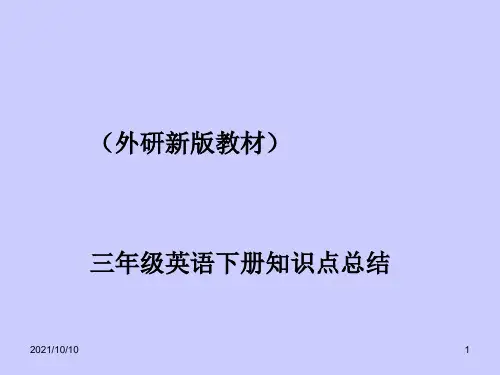
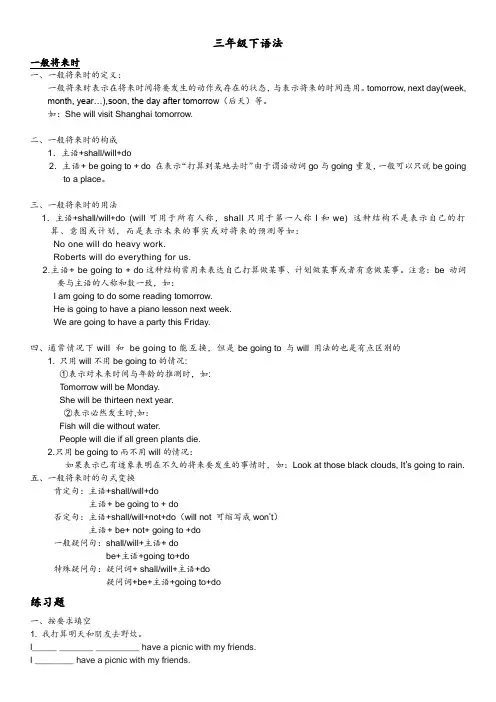
三年级下语法一般将来时一、一般将来时的定义:一般将来时表示在将来时间将要发生的动作或存在的状态,与表示将来的时间连用。
tomorrow, next day(week, month, year…),soon, the day after tomorrow(后天)等。
如:She will visit Shanghai tomorrow.二、一般将来时的构成1.主语+shall/will+do2. 主语+ be going to + do 在表示“打算到某地去时”由于谓语动词go与going重复,一般可以只说be goingto a place。
三、一般将来时的用法1.主语+shall/will+do (will可用于所有人称,shall只用于第一人称I和we) 这种结构不是表示自己的打算、意图或计划,而是表示未来的事实或对将来的预测等如:No one will do heavy work.Roberts will do everything for us.2.主语+ be going to + do这种结构常用来表达自己打算做某事、计划做某事或者有意做某事。
注意:be 动词要与主语的人称和数一致,如:I am going to do some reading tomorrow.He is going to have a piano lesson next week.We are going to have a party this Friday.四、通常情况下will 和be going to能互换,但是be going to 与will 用法的也是有点区别的1. 只用will不用be going to的情况:①表示对未来时间与年龄的推测时,如:Tomorrow will be Monday.She will be thirteen next year.②表示必然发生时,如:Fish will die without water.People will die if all green plants die.2.只用be going to而不用will的情况:如果表示已有迹象表明在不久的将来要发生的事情时,如:Look at those black clouds, It’s going to rain.五、一般将来时的句式变换肯定句:主语+shall/will+do主语+ be going to + do否定句:主语+shall/will+not+do(will not 可缩写成won’t)主语+ be+ not+ going to +do一般疑问句:shall/will+主语+ dobe+主语+going to+do特殊疑问句:疑问词+ shall/will+主语+do疑问词+be+主语+going to+do练习题一、按要求填空1. 我打算明天和朋友去野炊。
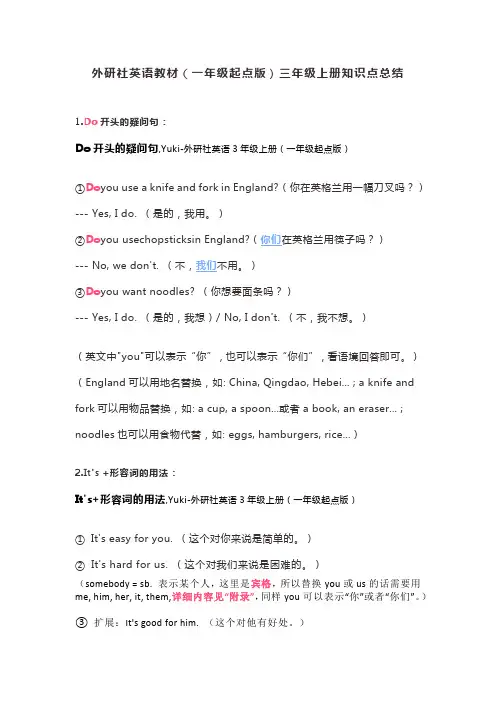
外研社英语教材(一年级起点版)三年级上册知识点总结1.Do开头的疑问句:Do开头的疑问句,Yuki-外研社英语3年级上册(一年级起点版)①Do you use a knife and fork in England? (你在英格兰用一幅刀叉吗?)--- Yes, I do. (是的,我用。
)②Do you usechopsticksin England?(你们在英格兰用筷子吗?)--- No, we don't. (不,我们不用。
)③Do you want noodles? (你想要面条吗?)--- Yes, I do. (是的,我想)/ No, I don't. (不,我不想。
)(英文中"you"可以表示“你”,也可以表示“你们”,看语境回答即可。
)(England可以用地名替换,如: China, Qingdao, Hebei... ; a knife and fork可以用物品替换,如: a cup, a spoon...或者a book, an eraser... ; noodles也可以用食物代替,如: eggs, hamburgers, rice...)2.It's +形容词的用法:It's+形容词的用法,Yuki-外研社英语3年级上册(一年级起点版)①It's easy for you. (这个对你来说是简单的。
)②It's hard for us. (这个对我们来说是困难的。
)(somebody = sb. 表示某个人,这里是宾格,所以替换you或us的话需要用me, him, her, it, them,详细内容见“附录”,同样you可以表示“你”或者“你们”。
)③ 扩展:It's good for him. (这个对他有好处。
)(easy/hard可以用形容词来代替,如: nice, bad...)3. be doing现在进行时特殊疑问句及回答:bedoing现在进行时特殊疑问句及回答,Yuki-外研社英语3年级上册(一年级起点版)①What are you do ing? (你正在做什么?)---I'm watch ing TV. (我正在看电视)②What are you do ing? (你们正在做什么?)---We're listen ing to music. (我们正在听音乐。
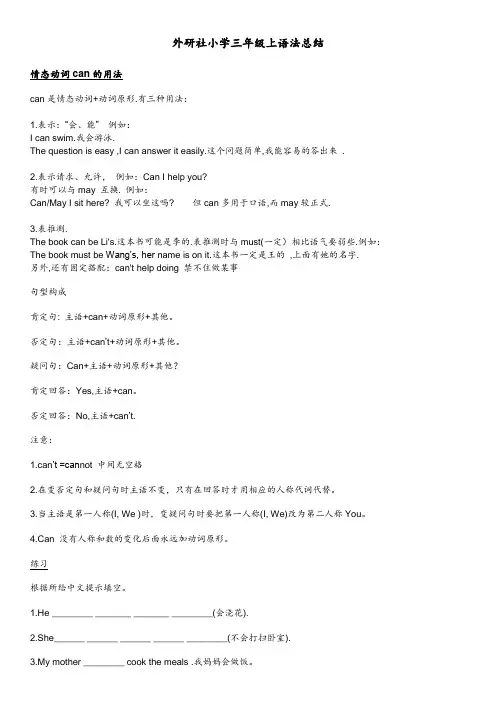
外研社小学三年级上语法总结情态动词can的用法can是情态动词+动词原形.有三种用法:1.表示:“会、能”例如:I can swim.我会游泳.The question is easy,Ican answer it easily.这个问题简单,我能容易的答出来 .2.表示请求、允许,例如:Can I help you?有时可以与may 互换.例如:Can/May I sit here?我可以坐这吗?但can多用于口语,而may较正式.3.表推测.The book can be Li's.这本书可能是李的.表推测时与must(一定)相比语气要弱些.例如:The book must be Wang’s, her name is on it.这本书一定是王的,上面有她的名字.另外,还有固定搭配:can't help doing 禁不住做某事句型构成肯定句: 主语+can+动词原形+其他。
否定句:主语+can’t+动词原形+其他。
疑问句:Can+主语+动词原形+其他?肯定回答:Yes,主语+can。
否定回答:No,主语+can’t.注意:1.can’t =can not 中间无空格2.在变否定句和疑问句时主语不变,只有在回答时才用相应的人称代词代替。
3.当主语是第一人称(I, We )时,变疑问句时要把第一人称(I, We)改为第二人称You。
4.Can 没有人称和数的变化后面永远加动词原形。
练习根据所给中文提示填空。
1.He ________ _______ _______ ________(会浇花).2.She______ ______ ______ ______ ________(不会打扫卧室).3.My mother ________ cook the meals .我妈妈会做饭。
4.她姐姐会说英语。
Her sister_______ speak English.5.你会唱歌吗?______ ______ sing?按要求改写句子Ms. Wang can play table tennis.(变否定句)We can make ice cream together. (变一般疑问句,并作肯定回答)I can play computer games. ( 对划线部分提问)补全对话1.A: ____________ you clean the bedroom?B: ____________, I can’t.A: What can you______________?B: I ____________ cook the meals and empty the trash.A: _____________ are helpful.2.A: ____________ can Amy do?B: She _____________ water the flowers and cook the meals.A: ___________ ___________ helpful. ____________ you cook the meals?B: ___________, Ican.Have got /has got的用法Have/Has got句型:它表示某物归某人所有,是一种所属关系,主语为人,只有“拥有”的意思Have/Has got句型的转换A、否定句:在Have或Has后加not, 缩写为Haven’t或Hasn’t.如:I have got three sisters. → I haven't got three sisters.He has got a bike. → He hasn't got a bike.B、一般疑问句与回答:把Have或Has提前到句首I have got three sisters. → Have you got three sisters? Yes,I have./No,I haven't.He has got a bike. → Has he got a bike? Yes, he has./No, he hasn't.用have got或has got填空。

外研社小学英语三年级起点重点句型、词组归纳第一册Module 11、 Hello... Hi...2、 Goodbye... Bye-bye...3、 How are you? I am fine,thank you.Module 21、 How are you? -- I am fine.And how are you? --I'm fine too.thank you.2、 What's your name? --I'm xx. --My name is xx.Module 31、 Stand up. Sit down.2、 Point to ...Module 41、 It's red\blue\yellow\green\black.2、 It's a red dog\cat.Module 51、 How many? 1--12Module 61、 What's this? --It's a desk\chair\bird.Module 71、 Happy Birthday!2、 Here 's your book.3、 How old are you? --I'm twelve.Module 81、 Look at...2、 Is it a cat? --Yes,It's a cat. --No,it isn't.It's a dragon.3、 Where's the book. --It's in the bag.Module 91、 This is my mother\father\grandpa\grandma\sister\brother. --She's\He's a doctor\teacher.Module 101、 This is her\his head\arm\hand\leg\foot\leg.第二册Module 11、二十六个字母手写体2、 My favourite toy is a ship\car\kite\doll\puter game.Module 21、 What's this? --It's a tiger\lion\elephant\monkey\panda. It's big\small.2、 What are they? --They are tigers\lions\elephants\monkeys\pandas. They arebig\small.3、 The tree is tall\short. This monkey is thin\fat.Module 31、 I like football\basketball\table tennis\morning exercises.2、 I don't like swimming\rid bikes\skipping.Module 41、 Do you like rice\noodles\meat\fish\mile. --Yes, I do. --No,I don't.2、 Does Daming like bananas\oranges\apples. --Yes,he\she does. --No,he\she doesn't.Module 51、 I get up\go to school\have lunch\go home\watch TV\go to bed at ... o'clock.2、 What's the time? --It's half past five.3、 I have breakfast\dinner at ... o'clock.Module 61、 What do you at ...o'clock in the morning\afternoon? --I play football. Module 71、 At Spring Festival, we have a big family dinner.2、 We have Christmas in England.Module 81、 What do you do in spring\summer\autumn\winter.Module 91、 Have you got a pen? --Yes, I have. --No, I haven't.2、 He\She has got a bike. He\She goes to work by car.Module 101、 The panda is in\on\under the desk.2、 In spring\summer\autumn\winter.第三册Module 11、 Point to 13-20.2、 Have you got a tiger? --Yes,I have. --No,I haven't.Module 21、 Excuse me. Where's the...,please?2、 Turn right\left. Go straight.Next\up\down\near\at station.Module 31、 What are you doing?2、 She's \He's --writing a letter. --taking pictures. --talking to her friend.--playing with a toy train.3、 I'm listening to music. --watching TV. --reading a book!Module 41、 What are they doing?2、 They are doing taijiquan. --rowing a dragon boat. --drinking soybean milk. --playing basketball. --playing table tennis. --jumping. --running.Module 51、 Do you want some rice\noodles? --Yes,please. --No,thank you.2、 He's making noodles. ---fast food.3、 I'm making dumplings. --cooking vegetables. --making cakes.Module 61、 I can jump high. Can you? --jump far. --ride fast. --Yes, I can. --No, Ican't.2、 I'm the winner.3、 Can you make a cake? --play the flute. --wash clothes. --draw a dragon. Module 71、 We are going to get up at 6 o'clock.2、 We are going to go by plane.3、 I am going to visit my grandpa.Module 81、 What are you going to do for Sports Days?2、 I'm going to run --the 100 metres.--every day.3、 I'm going to do the-- high jump.--long jump.4、 Good luck!Module 91、 Can I have some soup\sweets\bread?2、 Sorry, you can't.--Yes, you can.Module 101、 How many birthdays are there in July --There are three.2、 1-12 个月份。
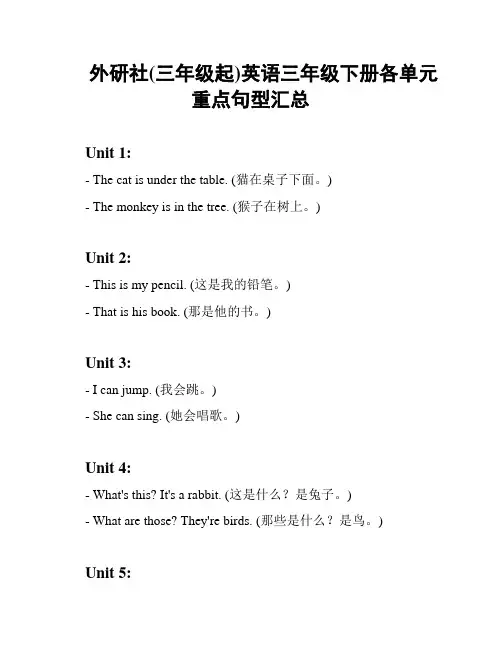
外研社(三年级起)英语三年级下册各单元重点句型汇总Unit 1:- The cat is under the table. (猫在桌子下面。
)- The monkey is in the tree. (猴子在树上。
)Unit 2:- This is my pencil. (这是我的铅笔。
)- That is his book. (那是他的书。
)Unit 3:- I can jump. (我会跳。
)- She can sing. (她会唱歌。
)Unit 4:- What's this? It's a rabbit. (这是什么?是兔子。
)- What are those? They're birds. (那些是什么?是鸟。
)Unit 5:- What do you want? I want a toy car. (你想要什么?我想要一辆玩具车。
)- What does she want? She wants a doll. (她想要什么?她想要一个洋娃娃。
)Unit 6:- Can you swim? Yes, I can. (你会游泳吗?是的,我会。
)- Can he run? No, he can't. (他会跑步吗?不,他不会。
)Unit 7:- I like dogs. (我喜欢狗。
)- She likes cats. (她喜欢猫。
)Unit 8:- Where are you going? I'm going to the park. (你去哪里?我去公园。
)- Where is he going? He's going to the supermarket. (他去哪里?他去超市。
)Unit 9:- I have a new dress. (我有一条新裙子。
)- He has a big balloon. (他有一个大气球。
)Unit 10:- What color is it? It's blue. (它是什么颜色?它是蓝色的。
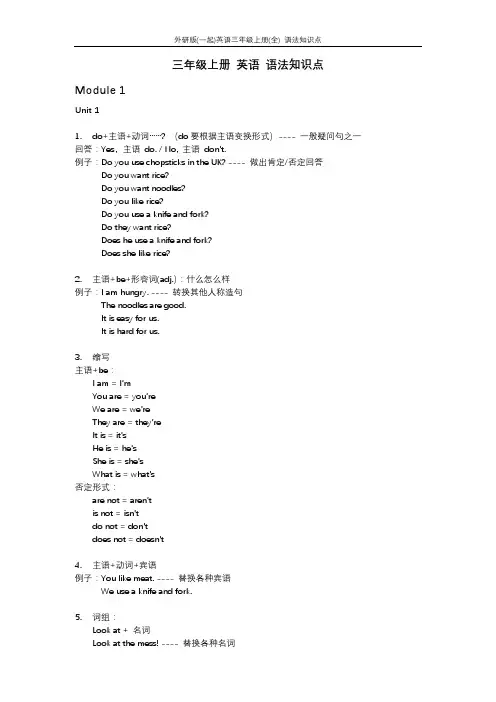
三年级上册英语语法知识点Module 1Unit 11.do+主语+动词……? (do要根据主语变换形式)---- 一般疑问句之一回答:Yes,主语do. / No, 主语don’t.例子:Do you use chopsticks in the UK? ---- 做出肯定/否定回答Do you want rice?Do you want noodles?Do you like rice?Do you use a knife and fork?Do they want rice?Does he use a knife and fork?Does she like rice?2.主语+be+形容词(adj.):什么怎么样例子:I am hungry. ---- 转换其他人称造句The noodles are good.It is easy for us.It is hard for us.3.缩写主语+be:I am = I’mYou are = you’reWe are = we’reThey are = they’reIt is = it’sHe is = he’sShe is = she’sWhat is = what’s否定形式:are not = aren’ti s not = isn’td o not = don’td oes not = doesn’t4.主语+动词+宾语例子:You like meat. ---- 替换各种宾语We use a knife and fork.5.词组:Look at + 名词Look at the mess! ---- 替换各种名词Look at me!Look !Unit 21.What + be + 主语+动词ing? 谁正在做什么?回答:主语+ be + doing…… 谁正在做什么。
What are you doing?What are you eating? ---- I am eating grass,(替换meat, rice, noodles, hamburgers and chips, apples. )2.现在进行时结构:be + 动词ing 正在……(四大时态之一)What are you eating? ---- 特殊疑问句---- 找出各自的be + doing What are you doing? ---- 特殊疑问句I’m eating grass. ---- 肯定句I’m eating meat.I’m eating hamburgers and chips.I’m using my hands.He’s using chopsticks.She’s using a knife and fork.3.be+主语+动词i ng……? (be要根据主语变换形式) ---- 一般疑问句之二回答:Yes,主语be. / No, 主语be not.Are you eating an apple? ---- 做出肯定/否定回答Are you eating a hamburger?Are they eating grass?Is he eating chips?Is she eating rice?Is your mother eating noodles?4.词组:Speak + 语言:说什么语言Speak EnglishSpeak ChineseSpeak JapaneseSpeak FrenchPlease 请Try them, please. (放最后的时候一般用逗号隔开)Please try them. (放前面不需要逗号隔开)Module 2Unit 15.现在进行时结构:be + 动词ing 正在……(四大时态之一)What are you doing? ---- 特殊疑问句---- 找出各自的be + doing We’re making a cake. ---- 肯定句We’re making a cake for you.We’re making a plane.I’m riding my bike.I’m making a cake.I’m reading.I’m working.Amy’s playing the piano.Sam’s playing the drums.(写出每个肯定句特殊疑问句)6.祈使句a)Let + 某人+ 动词原形+ 某事:让某人做某事Let’s make a cake for Mum and Dad.Let’s go to school.Let’s go home.Let me do it.缩写:l et’s = let us 让我们b)动词原形+ 宾格!or Be + 形容词!Be quiet!Please be quiet!Please go to your room!Please stop!7.词组:Good idea! 好主意!Thank you!谢谢你!Thanks!谢谢!Many thanks! 非常感谢!Yes!是的!Unit 21.现在进行时结构:be + 动词ing 正在……(四大时态之一)What are you doing? ---- 特殊疑问句---- 找出各自的be + doingWhat’s he doing?What’s she doing?What are they doing?I’m watching TV.I’m watering the flowers.He’s riding.She’s eating.He’s doing his homework.He is reading.He’s writing.She’s sleeping.They are drawing.She is getting up.We’re making ducks.We’re making planes.A cat is running.2.3.This is my bag.These are my books.Those are your books.缩写:that’s = that is4.词组:Here you are. 给你。
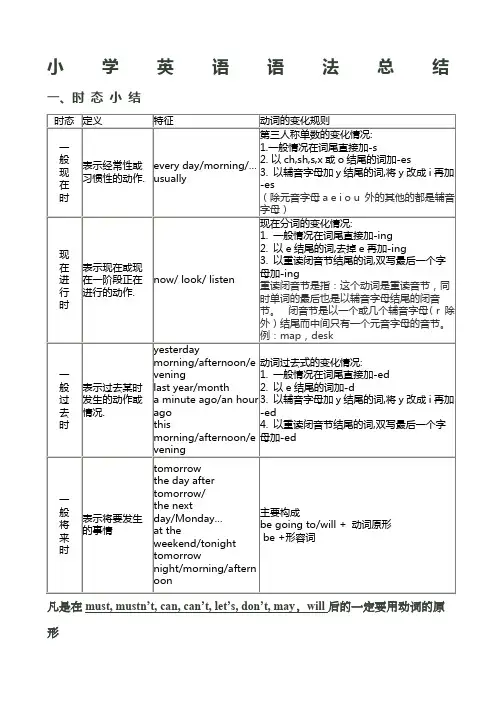
小学英语语法总结一、时态小结凡是在must, mustn’t, can, can’t, let’s, don’t, may,will后的一定要用动词的原形二、名词的复数。
名词按其数,可分两种:可数名词和不可数名词.可数名词的复数变化规则:1. 一般情况下,直接在词尾加-s, 如:girl-girls, book-books, pen-pens2. 以s,x,sh,ch结尾的词,在词后加-es, 如:class-classes, box-boxes, match-matches,3. 以辅音字母+y结尾的,变y 为i 再加-es, 如:city-cities, family-families, country- countries4. 以f或fe结尾的,变f或fe为v再加-es, 如:knife-knives, wife-wives, life-lives,5. 以o 结尾的加-es或-s, 如: radio-radios, tomato-tomatoes, potato-potatoes, zoo-zoos, photo-photos,6. man-men, woman-women, foot-feet, child-children,三、形容词的比较级、最高级。
形容词有比较级与最高级之分, 单音节词的变化规则:1. 一般情况下,直接在词尾加-er或-est, 如:small-smaller-smallest,short-shorter-shortest2. 以e结尾的,加-er或-est, 如:large-larger-largest, nice-nicer-nicest.3.以辅音字母+y结尾的, 变y 为i 再加-er或-est, 如:busy-busier-busiest,heavy-heavier-heaviest.4. 以重读闭音节,一个辅音字母结尾的,双写该字母,再加-er或-est,如:big-bigger-biggest, thin-thinner-thinnest.5. 多音节的词,前加more, most, 如: beautiful-more beautiful-most beautiful.6. good-better-best四、be 动词,助动词。
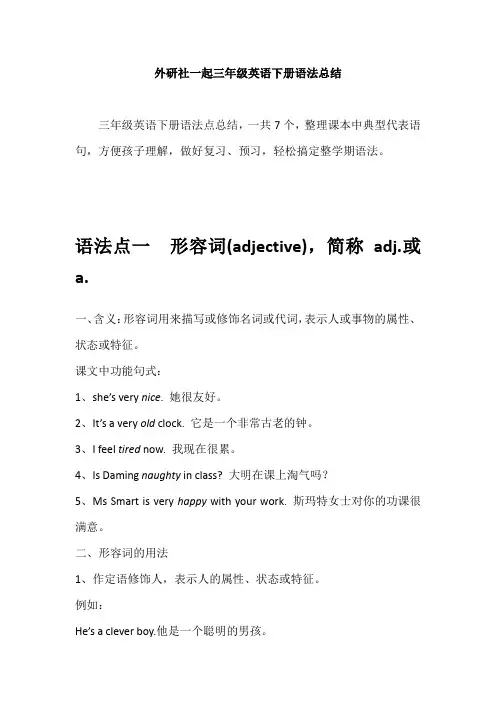
外研社一起三年级英语下册语法总结三年级英语下册语法点总结,一共7个,整理课本中典型代表语句,方便孩子理解,做好复习、预习,轻松搞定整学期语法。
语法点一形容词(adjective),简称adj.或a.一、含义:形容词用来描写或修饰名词或代词,表示人或事物的属性、状态或特征。
课文中功能句式:1、she’s very nice. 她很友好。
2、It’s a very old clock. 它是一个非常古老的钟。
3、I feel tired now. 我现在很累。
4、Is Daming naughty in class? 大明在课上淘气吗?5、Ms Smart is very happy with your work. 斯玛特女士对你的功课很满意。
二、形容词的用法1、作定语修饰人,表示人的属性、状态或特征。
例如:He’s a clever boy.他是一个聪明的男孩。
They very young then.他们那时很年轻。
He isn’t lazy.他不懒。
I’m very tall.我很高。
2、作定语修饰物,表示事物的属性、状态或特征。
例如:The river is very wide.这条河很宽。
The panda is very cute.这只熊猫很可爱。
It’s a black cat.它是一只黑猫。
记忆口诀:形容词句中作定语,放在名词、代词前。
不但可以修饰人,还能把物来评点。
三、形容词大致分类:1、品质形容词,表示人或物的品质。
例如:an old clock一个古老的钟2、颜色形容词,表示事物的颜色。
例如:blue sky 蓝天3、类属形容词,表示事物的类属。
例如:China is an Eastern country.中国是一个东方国家。
语法点二一般将来时be going to 结构含义:“be going to+动词原形”表示打算、计划或决定要做某事。
课文中功能句式:1、I’m going to help her.我打算帮助她。
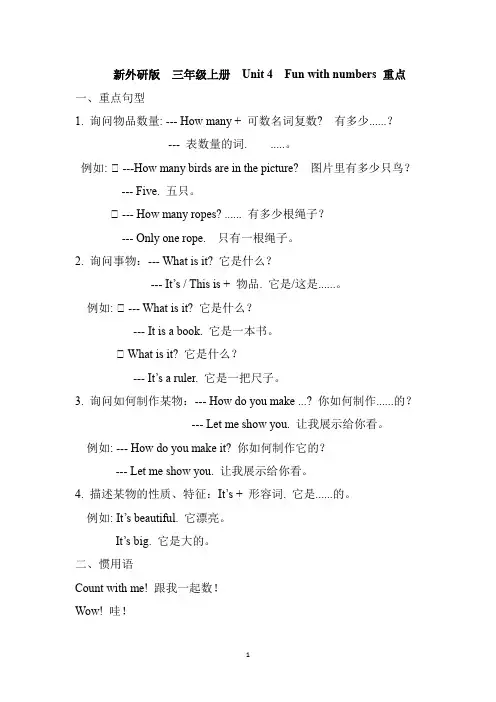
新外研版三年级上册Unit 4 Fun with numbers 重点一、重点句型1. 询问物品数量: --- How many + 可数名词复数? 有多少......?---表数量的词. .....。
例如: ① ---How many birds are in the picture? 图片里有多少只鸟?--- Five. 五只。
① --- How many ropes? ...... 有多少根绳子?--- Only one rope. 只有一根绳子。
2. 询问事物:--- What is it? 它是什么?--- It’s / This is + 物品. 它是/这是......。
例如: ① --- What is it? 它是什么?--- It is a book. 它是一本书。
① What is it? 它是什么?--- It’s a ruler. 它是一把尺子。
3. 询问如何制作某物:--- How do you make ...? 你如何制作......的?--- Let me show you. 让我展示给你看。
例如: --- How do you make it? 你如何制作它的?--- Let me show you. 让我展示给你看。
4. 描述某物的性质、特征:It’s + 形容词. 它是......的。
例如: It’s beautiful. 它漂亮。
It’s big. 它是大的。
二、惯用语Count with me! 跟我一起数!Wow! 哇!Guess!猜!Ha ha! 哈哈!Look!看!Let me show you. 让我展示给你看。
That's great! 太好了!That's amazing! 太神奇了!OK. 好的。
Er. 嗯Oh!噢!Oh,no! 噢,不!Let me count. 让我数一数。
三.动词及短语count 数数count with me 跟我数一数Let me count 让我数一数。
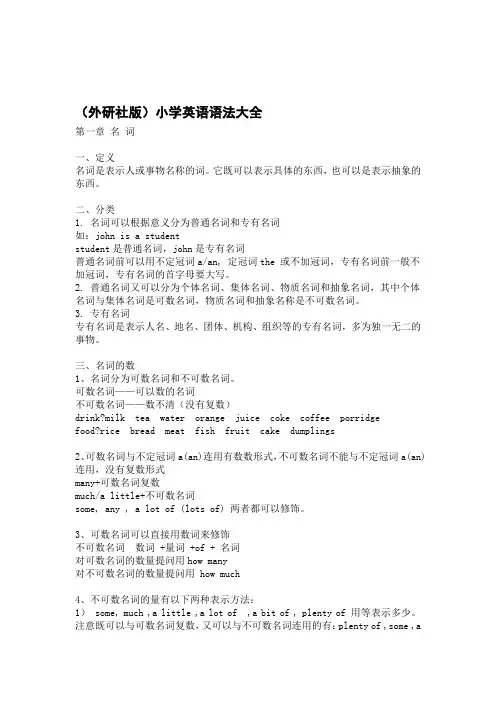
(外研社版)小学英语语法大全第一章名词一、定义名词是表示人或事物名称的词。
它既可以表示具体的东西,也可以是表示抽象的东西。
二、分类1. 名词可以根据意义分为普通名词和专有名词如:john is a studentstudent是普通名词,john是专有名词普通名词前可以用不定冠词a/an, 定冠词the 或不加冠词,专有名词前一般不加冠词,专有名词的首字母要大写。
2. 普通名词又可以分为个体名词、集体名词、物质名词和抽象名词,其中个体名词与集体名词是可数名词,物质名词和抽象名称是不可数名词。
3. 专有名词专有名词是表示人名、地名、团体、机构、组织等的专有名词,多为独一无二的事物。
三、名词的数1、名词分为可数名词和不可数名词。
可数名词——可以数的名词不可数名词——数不清(没有复数)drink?milk tea water orange juice coke coffee porridge food?rice bread meat fish fruit cake dumplings2、可数名词与不定冠词a(an)连用有数数形式,不可数名词不能与不定冠词a(an)连用,没有复数形式many+可数名词复数much/a little+不可数名词some, any , a lot of (lots of) 两者都可以修饰。
3、可数名词可以直接用数词来修饰不可数名词数词 +量词 +of + 名词对可数名词的数量提问用how many对不可数名词的数量提问用 how much4、不可数名词的量有以下两种表示方法:1) some, much ,a little ,a lot of ,a bit of , plenty of 用等表示多少。
注意既可以与可数名词复数,又可以与不可数名词连用的有:plenty of ,some ,alot of ,lotsof ,most of 等。
如there is much water in the bottle .瓶中有很多水。
【外研版】小学英语(三起点)三年级上册知识汇总Module 1 知识汇总一、词汇人称代词: I (我) you(你;你们)be动词:am / are(是)缩写形式:I’m = I am (我是)其他:aah(啊) ooh(嗬) hello/ hi(你好)goodbye / bye-bye(再见) good(好的)morning(早晨,上午) fine(健康的)二、常用表达三、重点句型自我介绍的句型:I’m ... / I am ...eg: I am Liu Mei.I’m Jim.Module 2 知识汇总一、词汇be动词:is(是)缩写形式:what’s = what is (是什么)其他:Ms(女士) boy(男孩) girl(女孩) whoops(哎呦)and(那么;和) too(也) ha ha(哈哈) what(什么) your(你的;你们的) name (名字) please(请)afternoon(下午) Mr(先生)二、常用表达三、重点句型询问对方名字:-What’s your name?-My name is ...eg: -What’s your name?-My name is Judy.Module 3 知识汇总一、词汇1. point 指2. to 向……3. the 这(那)个,这(那)些4. door 门5. sit 坐6. down 向下7. stand 站 8. up 向上 9. window 窗户10. blackboard 黑板 11. bird 鸟12. tweet (鸟)啾啾的叫声 13. desk 桌子14. chair 椅子二、常用表达三、重点句型1. Point to + 某人/某物. 指向某人或某物。
eg: Point to the door.eg: Point to the boys.外研(三起)三年级Module 4 知识汇总一、词汇缩写:it’s = it is它是其他: 1. it 它 2. red 红色的 3. look 看4. wow 呀,哇5. yellow 黄色的6. blue 蓝色的7. a (an) 一个,一 8. chameleon 变色龙 9. my 我的10. panda 熊猫 11. now 现在12. green 绿色的 13. black 黑色的14. dog 狗 15. cat 猫 16. cap 帽二、重点句型1. It’s +表示颜色的形容词.eg: It’s red.2. I t’s a/an +表示颜色的形容词+可数名词单数.eg: It’s a black dog.Module 5 知识汇总一、词汇1. one 一2. two 二3. three 三4. four四5. five 五6. six 六7. seven 七 8. eight 八9. nine九 10. oh 噢,哦11. ten 十 12. eleven 十一13. twelve 十二二、习惯搭配1. little fingers 小手指2. on my hands 在我的手上3. nine girls 九个女孩4. how many多少三、重点句型1. –How many (+可数名词复数+其他) ?–基数词.eg: –How many dogs? –Five.译文:多少只狗?五只。
外研版英语三年级上册语法知识点外研版英语三年级上册语法知识点一、名词1、可数名词和不可数名词:学习名词时,首先要掌握可数名词和不可数名词的规则。
可数名词是可以计数或可以分成一个个物体的名词,例如:book、desk、window等。
不可数名词是无法计数或不能分成一个个物体的名词,例如:water、rice等。
2、名词的复数形式:可数名词在使用时通常需要加上复数后缀,例如:-s、-es、-ies等。
需要根据不同的词尾进行变化。
3、专有名词和普通名词:英语中的名词可以分为专有名词和普通名词。
专有名词是指特定的人或物,例如:China、New York等。
普通名词则是一般性的名词,例如:dog、cat等。
二、动词1、动词的基本形式:英语中的动词有基本形式、现在时态和过去时态。
基本形式包括原形、第三人称单数、过去式和过去分词。
例如:run-runs-runs-run。
2、动词的用法:动词是句子中表示动作或状态的词语。
在英语中,每个句子都必须有一个动词。
如果句子没有动词,就需要使用系动词(如is、are、was等)。
三、时态1、现在进行时:表示现在正在进行的动作或目前的状态。
结构为“be 动词+动词ing形式”。
例如:I am studying English。
2、一般现在时:表示通常性、规律性或习惯性的动作或状态。
结构为“动词原形”。
例如:I go to school every day。
3、过去完成时:表示过去的某个时间点已经完成的动作。
结构为“had+过去分词”。
例如:They had finished their homework。
四、语态1、主动语态和被动语态:语态是指描述句子的角度,即主语和谓语动词之间的关系。
主动语态表示主语是动作的执行者,被动语态表示主语是动作的承受者。
例如:The dog bites the cat。
(主动语态)The cat is bitten by the dog。
(被动语态)2、语态的转换:在英语中,可以通过改变动词的形式来转换语态。
小学英语语法总结一、时态小结凡是在must, mustn’t, can, can’t, let’s, don’t, may,will后的一定要用动词的原形二、名词的复数。
名词按其数,可分两种:可数名词和不可数名词.可数名词的复数变化规则:1. 一般情况下,直接在词尾加-s, 如:girl-girls, book-books, pen-pens2. 以s,x,sh,ch结尾的词,在词后加-es, 如:class-classes, box-boxes, match-matches,3. 以辅音字母+y结尾的,变y 为i 再加-es, 如:city-cities, family-families, country- countries4. 以f或fe结尾的,变f或fe为v再加-es, 如:knife-knives, wife-wives, life-lives,5. 以o 结尾的加-es或-s, 如: radio-radios, tomato-tomatoes, potato-potatoes, zoo-zoos, photo-photos,6. man-men, woman-women, foot-feet, child-children,三、形容词的比较级、最高级。
形容词有比较级与最高级之分, 单音节词的变化规则:1. 一般情况下,直接在词尾加-er或-est, 如:small-smaller-smallest,short-shorter-shortest2. 以e结尾的,加-er或-est, 如:large-larger-largest, nice-nicer-nicest.3.以辅音字母+y结尾的, 变y 为i 再加-er或-est, 如:busy-busier-busiest,heavy-heavier-heaviest.4. 以重读闭音节,一个辅音字母结尾的,双写该字母,再加-er或-est,如:big-bigger-biggest, thin-thinner-thinnest.5. 多音节的词,前加more, most, 如: beautiful-more beautiful-most beautiful.6. good-better-best四、be 动词,助动词。
三年级上下册英语知识点一、名词1、人物:Ms Mr boy girl teacher pupil mother father sister brother grandpa grandma doctor policeman nurse driver farmer man mum dad friend2、事物:window blackboard desk chair cap present pencil pen cake bag schoolbag ball book kite TV football basketball table tennis morning exercises bike phone snow rain toy box tree bed line bus car hat photo3、食物:meat rice noodles fish milk orange apple banana pear4、服装clothes:sweater dress coat T-shirt trousers shirt shoe skirt5、身体部位:head leg foot arm hand nose eye mouth ear6、地点:classroom school zoo bedroom park lake7、科目:English music Chinese maths art PE science8、星期:Monday Saturday Sunday9、季节season:spring summer autumn winter10、动物animal:bird panda dog cat monkey tiger lion elephant 二、代词1、人称代词:I my you your he his she her it they them we2、物主代词:this that三、动词1、Be动词:am is are2、助动词:do does3、实义动词:point look say like ride swim skip go play do eat sleep watch have/has fly/flies walk have got open四、形容词1、颜色:red yellow blue green black brown orange white2、特征:fat short tall small thin big warm hot cool cold sunny windy funny五、数词:one two three four five six seven eight nine ten eleven twelve六、介词:in on with at under for behind about by七、连词:and but八、疑问词:what how many how old who九、缩写词:what’s it’s here’s you’re don’t where’s she’s he’s that’s they’re doesn’t haven’t hasn’t let’s can’t 十、短语:point to stand up sit downin the morning in the afternoonplay football go to school at homeat school on Monday go to work go shopping go fishing go swimming ride a bike watch TV have class play basketball fly kites go skating in spring by bus by car十一、句型:1. I like / don’t like....2. I have got / haven’t got...3. She has got / hasn’t got...4. It’s your turn.十二、日常用语:1.-Hi. -Hello.2.-Goodbye. -Bye-bye.3. -Good morning. -Good morning.4. -Good afternoon. -Good afternoon.5. -What’s your name? -I’m.../ My name is...6. -How are you? -I’m fine,thank you.7. -How many...? -One, two, three...8. -Happy birthday. -Thank you.9. -Here’s your present. -Thank you.10. -What’s this? -It’s a pen.11. -What’s that? -It’s a schoolbag.12. -How old are you? -I’m nine.13. -What’s that? -I don’t know.14. -Is it a cat? -Yes, it is. / No, it isn’t.15. -Where’s the bird? -It’s in the blue bag.16. -Is this your sister? -Yes, it is. / No, it isn’t.17. -What’s your favourite song?-It’s ABC song. 18.-What’s your favourite colour?-My favourite colour is ...19.-Here you are. -Thank you.20. -What are they? -They’re lions.21. -Do you like meat?-Yes, I do. / No, I don’t.22.-Is Amy at home?-Yes, she is. / No, she isn’t.23.-Is Sam at home?-Yes, he is. / No, he isn’t.24.-Who’s that? -It’s Tom.25-Does your mum go to work on Saturday? -Yes, she does. / No, she doesn’t.26.-Do you go swimming on Sundays?-Yes, I do. / No, I don’t.27.-What do you do in the morning?- I ride my bike in the morning.28.-What do you have at school today?-I have Music.29.-What do you do in spring? - I fly a kite.30. -Where is the pen? -It’s under the book.31. -Have you got a new book?- Yes, I have. / No, I haven’t.32.-Has Amy got a bike?-Yes, she has. / No, she hasn’t.。
三年级英语外研版新教材2024版
一、单词方面。
1. 常见的动物单词。
- cat(猫),狗(dog),panda(熊猫)等。
可以通过制作单词卡片,一面写单词,一面画对应的动物图案,帮助记忆。
2. 颜色单词。
- red(红色),blue(蓝色),green(绿色)。
可以用不同颜色的彩笔来书写单词,加深对颜色和单词的联系。
二、句型方面。
1. 介绍自己。
- I'm...(我是……),如I'm Tom.(我是汤姆)。
可以和同学互相练习介绍自己的名字。
2. 描述事物。
- It's a...(它是一个……),例如It's a book.(它是一本书)。
利用身边的物品进行句型练习。
三、语法方面(简单涉及)
1. 名词的单复数。
- 像cat是单数,cats就是复数形式。
可以通过对比一个猫和多个猫的图片来理解单复数概念。
外研版(三起)三年级英语上册全册知识点清单Module 1一、核心词汇1. 人称代词: I我you你;你们2. 感叹词: aah啊hello(hi)你好ooh嗬goodbye(bye-bye)再见3. be动词: am是are是4. 形容词: good好的fine健康的5. 表示时间的名词: morning早晨,上午6. 动词: thank谢谢二、拓展词汇1. 其他常见人称代词: he他she她it它we我们they他(她、它)们2. be动词: is是3. 其他表示时间的名词: noon中午,正午afternoon下午night晚上,夜晚三、核心句型1. Hello, I m Sam. 你好,我是萨姆。
解读:这是进行自我介绍时的一般用语,也可用来回答“What s your name?”这个询问对方姓名的问句。
句中的I m 是I am的缩写形式,其中am为be动词且只用在I后。
举一反三: I m Li Ming.=I am Li Ming. 我是李明。
2. — Goodbye, Lingling. 再见,玲玲。
— Goodbye, Daming. 再见,大明。
— Bye-bye, Amy. 再见,埃米。
— Bye-bye, Sam. 再见,萨姆。
解读:这是表示“再见”的常用句型。
“Goodbye!”是大家常用的且较为正式的告别语,多用于陌生人或年长的人。
“Bye-bye.”则较为口语化。
举一反三: — Goodbye, it s too late. 再见,太晚了。
— Bye-bye. 再见。
3. Good morning, Daming!早上好,大明!解读:这是在一天的早上或上午向他人问好的句型。
举一反三: — Good morning, everyone. 大家早上好。
— Good morning, Mrs Green. 早上好,格林夫人。
4. — How are you, Sam? 你好么,萨姆?— I m fine, thank you. 我很好,谢谢。